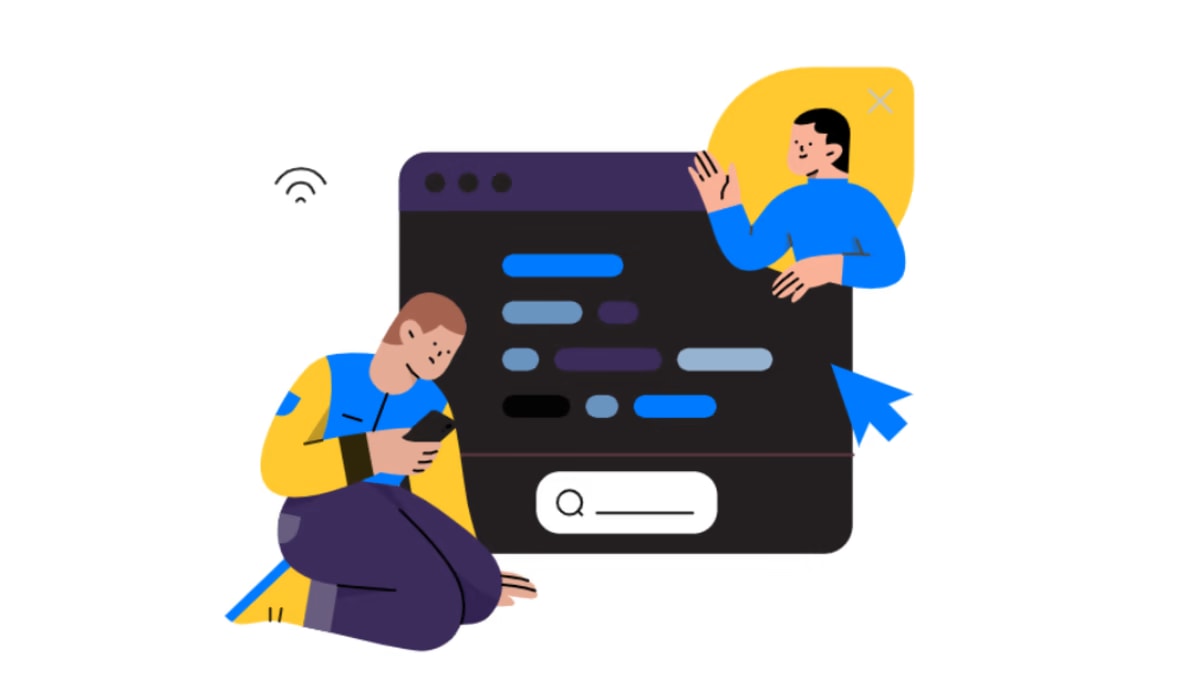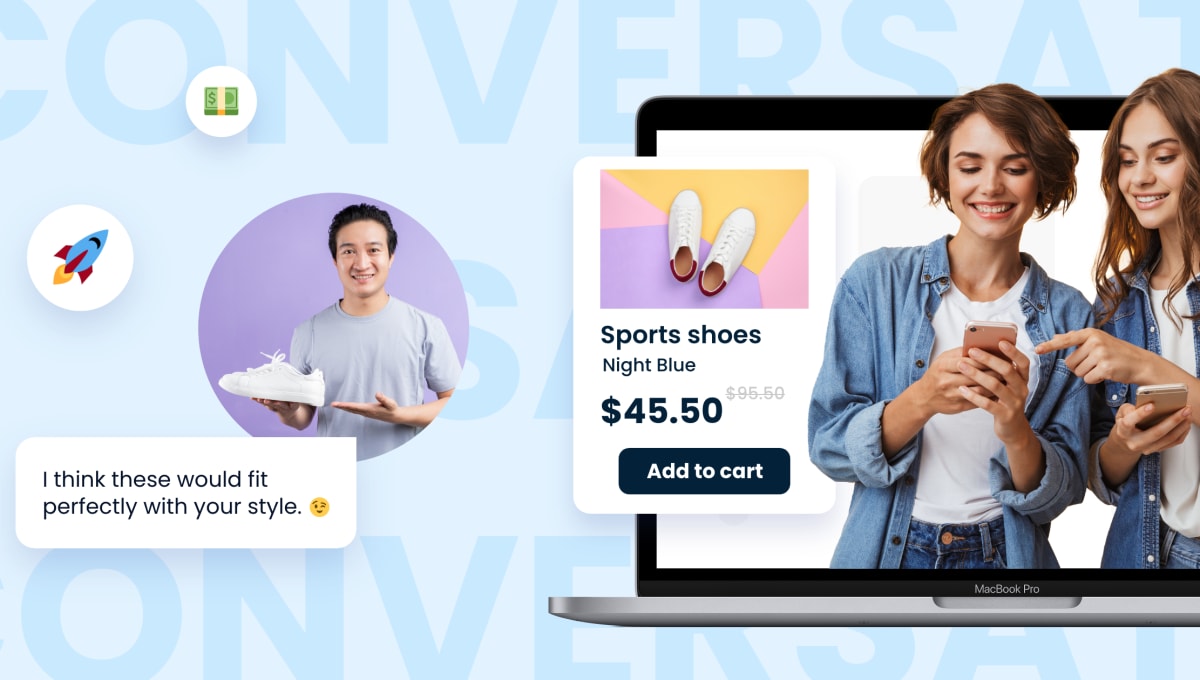Check out how to master conversational selling and easily seal the deal with potential customers. Scroll down for the finest tips and tricks, and take your sales skills to the next level.
Table of contents
Let’s talk! If you want to close more deals and generate qualified leads, conversational selling is something worth giving a go.
Not sure how to do it? In this article, we will share tips and tricks to help you build a better relationship with a potential customer, ask questions, and accelerate rigid sales processes.
No more scripted lines or pushy tactics, just good old-fashioned communication.
Are you ready? Let’s jump right in our guide to conversational sales.
What are conversational sales?
Conversational sales is simply chatting or talking with existing customers and prospects to close sales. It might involve tools like live chat, chatbots, orphones.
But it’s not only about closing sales.
Conversational marketing is a way of getting to know your target audience and providing them with impeccable customer service. ✨
But how does it really work? Instead of bombarding customers with product details and promotions, conversational sales involves asking open-ended questions and actively listening to the answers. As a result, a salesperson can better understand what the customer is looking for and tailor their approach accordingly.

Conversational sales formula: What is it?
There are no numbers, multiplying, or percentages in the conversational sales formula. It’s a simple way to talk to customers and sell things.
Start a conversation – create a warm connection with customers, essential for a memorable sales experience. Listen deeply to their needs, a foundation to improve sales. Teach them about your product’s benefits, and boost sales productivity at the same time.
Next, customize your solution to their specific situation, and show your commitment to their expectations. In sales training, you learn to handle customer doubts smoothly. Guide them gently to make a purchase. After closing the deal, keep in touch. It’s a way to build lasting relationships.
This may serve as the conversational sales framework – connect, listen, offer, and make them happy with your product.
Simple yet powerful.
Okay, but how to combine modern sales (online sales) and a conversational approach? Chatbots and live chat are the best fit here! If your sales teams haven’t adapted this communicational channel, maybe it’s worth a shot. Works great in inbound and b2b sales as well.
Benefits of conversational sales
Conversational sales make selling products or services while conversing with prospects is full of benefits. Check them out. Some might be surprising.
01 It builds relationships with customers
As the saying goes, people buy from people they like. And that’s exactly what conversational sales is all about - building relationships and a genuine connection with your customers. Engaging in casual, natural conversations with potential buyers lets sales reps establish a bond beyond just trying to sell a product.
Take time to listen to the customer’s needs and preferences. And when a potential buyer feels heard and understood, they are much more likely to become a loyal repeat customer.
It’s a win-win situation 1️⃣:1️⃣.
02 It makes you stand out from the competitors
The secret to standing out from your competitors is not just having the best products or the flashiest website. It’s more about keeping customers happy. And that’s where conversational sales comes in.
Outstanding customer service might be something that will differentiate you from the crowd. And let’s face it - the e-commerce industry is just huge. Luckily, tools likelive chat can really save the day.
Oh! Did you know thatSmartsupp provides excellent live chat software?
03 It increases sales
Keeping in touch with your customers may boost your revenue. You’re making prospects feel valued and appreciated by being available to help them choose the right product, offering discounts, and being there for them whenever they need assistance. This, in turn, makes them more likely to recommend your products or services to others.
And the good news here - conversational sales let e-shop owners gather some valuable customer data, like their preferences and buying habits.
📰 Learn more aboutmaximizing your conversion rates.
04 It gives a bigger picture of your customers’ needs and preferences
When you talk with customers on a daily basis, you’ll get familiar with their likings and preferences as the conversation goes. But not only. You’ll also learn what they have problems with and what on your website needs a little fix-up.
Take advantage of it! Listen carefully to a customer’s problem, and catch any inconsistencies and inconveniences. Then, fix your website the way they suggested.
05 It shortens the customer journey and the sales cycle
As an e-commerce business owner, you probably know that the customer journey can take a long and winding road. There are many touchpoints on the way. Beginning with the initial discovery of your brand and ending with the final purchase.
What’s more, there are many twists and turns that might put customers in a bind. Here’s when conversational sales come into play. Engage customers in a friendly, natural conversation, and guide them to navigate the buying process with ease. Feel free to use a live chat for it!
OK, now it’s time to clarify the sales cycle part. It is the series of stages a prospective buyer goes through before purchasing. The sales cycles look like this:
- lead generation,
- lead qualification,
- needs analysis,
- proposal,
- and closing the deal.
Through conversational marketing, you can remarkably reduce the sales cycle. In other words, by talking or chatting with a potential customer, you support them. This, in turn, results in better customer satisfaction and improved customer success.

Tips and tricks for conversational marketing
Want to implement a conversational sales methodology but need some guidance and tips? You’re in the right place!
Below, we’ve prepared some tricks that will get you connected with potential customers and boost conversational selling.
Ready? Off we go - your complete guide is right here.
#1 Understand your customers and website visitors
One of the most critical things when talking to customers is approaching them with understanding.
When sales reps chat via live chat (or another tool), it’s vital to remember that they browse your website for all sorts of reasons - maybe they are looking for a gift, maybe they’re bored with window shopping, or maybe they just want to get to see what the fuss is all about.
Keep in mind that to assist a website visitor in finding the right product, be open-minded and understanding. It involves being patient, empathetic, and helpful. Trust us, if you approach customers with a friendly and understanding attitude, they’ll feel more comfortable with you.
#2 Ask effective questions
The first question you may ask is: OK, but what are effective questions? These are open-ended questions that make new leads share their thoughts, feelings, and opinions with you and your sales and marketing teams.
Let’s take a look at some examples:
- What brought you to our website today?
- What are you looking for in a [product/service]?
- Can you tell me more about [specific feature or benefit] you’re interested in?
- What challenges are you facing in your [industry/job/role]?
- How important is [specific factor] to you when making a purchase decision?
And their (questions’) superpower is that they’re super insightful! Asking open-ended questions opens to door to genuine opinions and customer intentions.
Then, it’s much easier to provide visitors with the best customer experience, service, and recommendations.
#3 Listen actively
Active listening is such a valuable skill! It is also useful in customer service and conversational sales. It is all about paying close attention to what the customer says and showing them that you understand their perspective.
Where to start at?
Well, using live chat or phone is a bit more challenging than talking in person. But it doesn’t mean that it is not doable. It is! With a few tips, you may be able to achieve great results. Don’t worry, we’ve got you covered.
👉🏻 Summarize or paraphrase what the customer said or wrote. It’s a signal that you understand what they mean and can clear some doubts if you have any.
👉🏻 Ask clarifying and relevant questions.
👉🏻Listen without being judgemental, and don’t jump to conclusions too early.
👉🏻 Offer solutions, and if it’s not possible, keep prospects informed about what you’re doing to do next (for example, that you’re about to forward the message to a person who is qualified to help).
#4 Use a friendly and respectful tone
Would you want to buy something from someone who sounded rude or dismissive? Of course not!
A friendly and respectful tone is crucial in sales and in communication in general. It is how you show your customers that you care about them as individuals and not only potential sales. Also, the way you speak, language andtone establish trust and credibility.
Did you know that at Smartsupp, shortcuts enable agents to send a prewritten message? Write some thoughtful words and share your kindness within seconds!
Speak with kindness, empathy, and respect, and watch your sales soar 🚀

#5 Implement a reliable tool for conversational sales
If you’re trying to sell a product or service, but your communication tool keeps glitching or going down, you’re not going to come across as professional or trustworthy.
That’s why a reliable tool is a must. But finding the one that works well and is budget-friendly is not an easy task. But we’ve got an irrecusable proposition. What about Smartsupp? It provides a surefire live chat, and both visitors and sales reps will enjoy it!
Features and tools like multichannel chats, integrations, customization, customer insights, and achatbot make it a reliable platform and ideal solution for e-commerce businesses.

#6 Initiate the sales conversation
How not to miss a selling opportunity? By sending a message first! However, you need to be careful here. Nobody likes intrusive messages, especially when enjoying the time shopping online. So, what to do instead? Automatic messages may come in handy.
At Smartsupp creating automatic messages on your website is quick and straightforward. Set up the conditions, write the text, et voilà! The good idea is to send such messages when:
- a user is inactive for a moment
- they return to your website
- customers enter specific pages
It’s up to you. So, why wait? Start the conversation without having to lift a finger and make it easier to engage with potential customers and improve your sales numbers.
💡If you want to hear back from a visitor, the first interaction ought to be welcoming and encouraging.
#7 Keep improving communication skills and sales strategy
No matter what industry you work in, you must always strive to improve. And especially when it comes to communication with customers. So, if you’re an e-shop owner and feel like a little support in upskilling your communication, maybe investing in some courses is a good idea. Or, at least, try to gain new knowledge on your own.
But, on a daily basis, it’s vital to keep practicing active listening, asking the right questions, and using a friendly tone and language.
The better you and your team get at engaging in meaningful conversations, the more successful you’ll be in closing deals and building rapport. Moreover, you’ll prevent poor customer experience.
Use Smartsupp for conversational marketing and sales
Smartsupp is an ideal platform for e-commerce and customer care. Packed with a solid set of features and tools, it offers a robust toolkit that plays a vital role in sales efforts andsales plans. Once you meet Smartsupp, you won’t want to change it to anything else. Just take take a look!
Usability
Even if you’re not a tech whiz, Smartsupp is a breeze to operate andset up. It provides sales teams with a simple interface with easy-to-use tools, allowing you to personalize a chat widget, chat window, and more.
Affordable
With our tool, you’ll never have to worry about going broke. Unlike other chat software out there, Smartsupp comes with a free plan that offers must-haves such as live chat, chat history, and mobile support.
Looking for more advanced features like chatbots, and analytics? There are several affordable pricing plans to choose from, perfect for businesses of all shapes and sizes.
Shortcuts
A sales rep who specializes in conversational selling chats with customers constantly. Let’s be honest, sometimes you end up sending the same (or very similar) messages over and over again.
That’s where shortcuts are useful. They’re pre-written messages that you can tweak on the fly before sending, saving you the hassle of typing out repetitive messages every time. Automate chatting and keep the human touch in one go.
Automatic messages
They’re also known as triggers and are an excellent feature for conversational selling.Automatic messages enable operators to invite visitors to chat conversations without manual intervention. It means you reach out to your potential customers at just the right moment and easily steer them toward a conversion.
Chatbot support
Meet Smarty, the chatbot from Smartupp! It’s a little helper when sales team members are off the clock. Set it up as a first-line filter, a shopping guide, or a recurring question assistant.
Conversational sales wrapped up
Are you tired of the same old sales pitches and robotic customer interactions? Well, let’s get started with conversational sales! It might be the shortcut your customers have been looking for. And with our tips and tricks, it will be much easier for you to get going.
Try out Smartsupp. 🚀Sign up for free and maximize revenue thanks to productive sales conversations.
FAQs
Before asking questions about conversational sales strategy, check the FAQ section. Maybe the answer is already here.
What is conversational selling?
Conversational sales is the sales approach that involves engaging in personalized and meaningful conversations with prospects to build trust. The idea is to create a real-time dialogue that feels natural and human (similar to face to face conversation) rather than just pushing a product or service.
How can conversational approach help the sales team?
Conversational sales approach allows sales to better understand prospects’ needs and pain points, ultimately resulting in more effective sales. Also, it is a way of developing a mutual connection and creating a memorable buying experience. And compared to traditional sales in a brick-and-mortar store, there are more automation options (bots, live chat, and more).
What are some common techniques used for conversational sales?
Conversational sales techniques include active listening, asking open-ended questions, providing relevant and valuable information, using an appropriate tone, engaging prospects, and listening to their concerns and needs. The key is to create a two-way conversation that feels natural and comfortable for both parties.
How do I know when to close the sales process?
It might be tricky, but just look for buying signals from the prospect indicating they might be ready to purchase. For example, asking for pricing, shipping options, or additional features. Want to learn more about closing sales? Read about8 closing techniques for sales success.
What are some mistakes to avoid during conversational sales in b2b and more?
Some common mistakes to avoid during conversational sales are:
- talking too much,
- not listening to the prospect’s needs,
- being too pushy or aggressive,
- not providing enough information,
- following up late.
Keep it relevant, informative, and respectful of the prospect’s interest, time, and needs.

